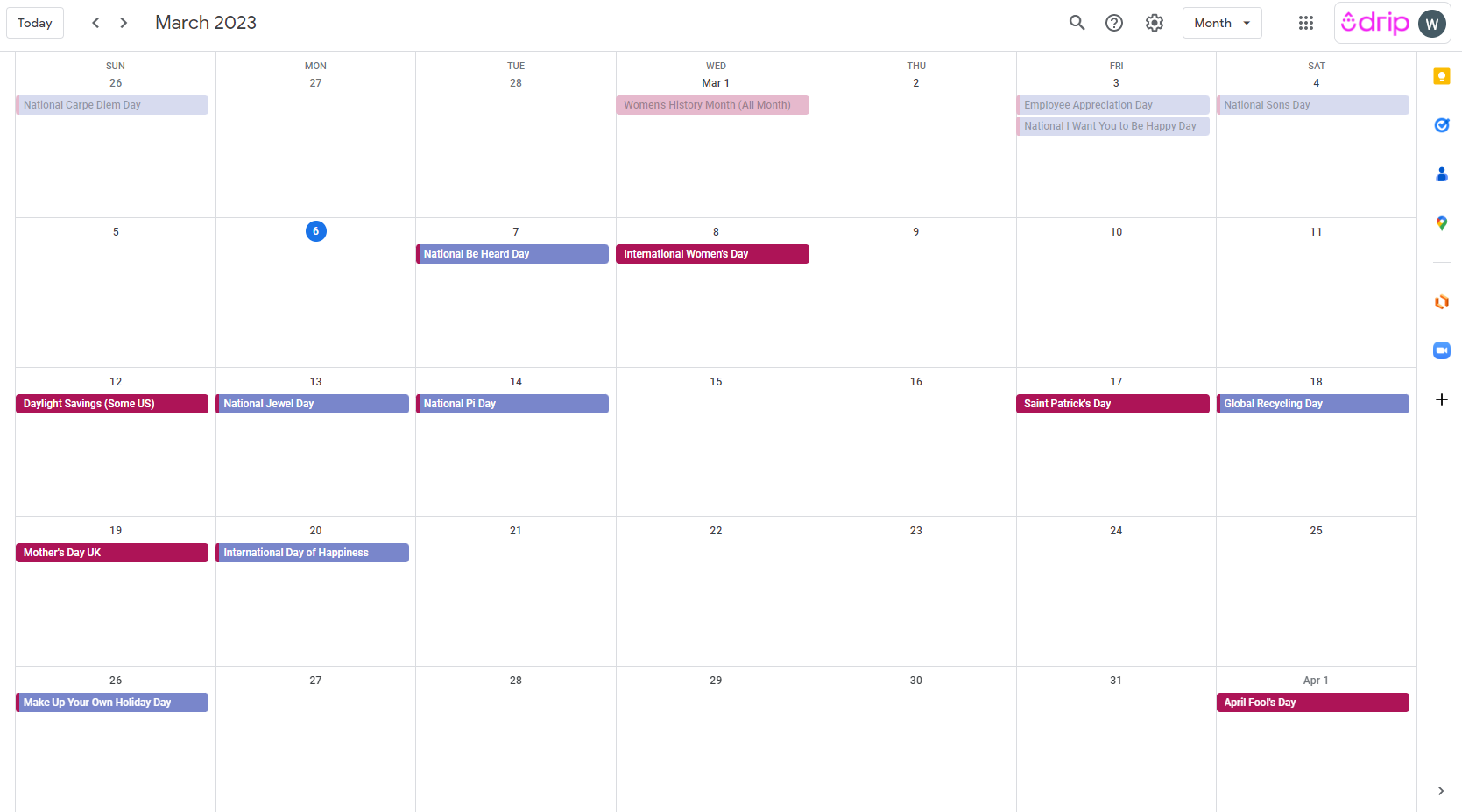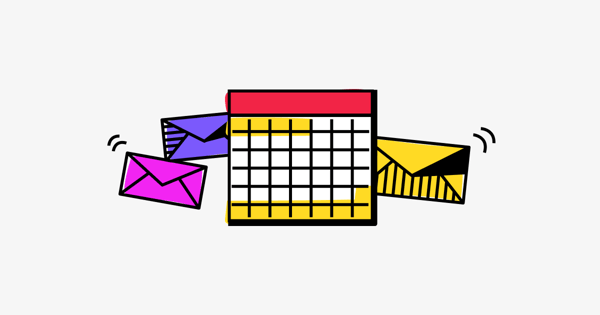You’re probably facing a lot of competition in your niche.
It’s fierce out there.
For online sellers, this means one thing: you’ve got to find a way to outdo the competition to maintain your position in the market.
One great way to either keep up or out-perform the competition: ecommerce holidays.
Ecommerce holidays are a unique way (read: excuse) to reach out to your customers and offer deals, promotions, new products, and more. While ecommerce holidays sometimes correspond to actual holidays, they can sometimes be bizarre or even funny.
But it’s about delighting your customer. So if you want to write out an email in pirate speech for Talk Like a Pirate Day (Sep 19) — we’re not going to be the ones that stop you.
In this article, we’ll give you tips on preparing your store for the larger ecommerce holidays, plus offer tons of ecommerce holidays you’ve probably never heard of (with examples and resources).
Download the Ecommerce Holiday Calendar Template
We created the ultimate ecommerce holiday calendar, so you’ll never have to plan promos at the last minute ever again.
 Unless, you’re one of those people who thrives under pressure. We see you too.
Unless, you’re one of those people who thrives under pressure. We see you too.
How to Use the Ultimate Ecommerce Holiday Calendar
We created this resource to give you not only a working content calendar for your biggest ecommerce holidays, but also to give you a benchmark for lesser-known, and also forgotten holidays.
The list of potential holidays is far from exhaustive. But we tried to think of reasons you’d want to reach out to your customers. While the calendar is heavily US-focused, it does offer a few international holidays for those who sell cross-border.
For example, Make Up Your Own Holiday Day is March 26th this year, meaning you have an excuse to reach out to your customers with whatever made up holiday you’d like.
Or, offering Gifts for Him ahead of Husband Appreciation Day (April 15th).
What’s included in the ultimate ecommerce holiday calendar:
- Major/popular holidays and shopping events (marked with an asterisk)
- Resources inside most major holidays with examples for you to steal
- Resources attached to the first of each month (for example, March Resources on March 1st).
- Reminders to begin planning ahead of your biggest campaigns of the year
- A few culturally-sensitive days to help you avoid a faux pas
As we create more holiday-focused resources, we’ll be adding to the calendar as we go.
So how can you get the calendar? Simply add it to your Google calendars, and get a full view of your year!
How to Prepare Your Online Store for an Upcoming Holiday (With Examples)
The ecommerce brands that truly take advantage of holidays have a plan.
They don’t let important holidays sneak up on them. They have planned for them, and they have a clear idea of how to carry out those plans.
For instance, every online brand has its sights set on one massive holiday: Black Friday.
There’s no exception.
If you’re not “going big” on Black Friday, you’re missing out.
It takes many weeks (or longer) of planning to prepare for Black Friday sales and everything that goes along with it.
- Have you teased your upcoming sale with a November newsletter?
- Have you decided which items to put on sale?
- Do you have all the resources needed to respond to the uptick in service requests?
You get the point. The planning you do in advance of a holiday dictates your experience and overall success.
Here are five steps you can take to prepare your online store for 2023 ecommerce holidays.
1. Prepare for a Spike in Website Traffic
Some holidays, such as Black Friday and Cyber Monday, will drive more traffic to your website than others. You should also consider other major ecommerce holidays that drive your visitor count to new heights.
A website crash resulting from high traffic is the worst thing that could happen. This takes your online store offline, making it impossible for people to shop.
All of your hard work preparing for the holiday goes out the window.
It’s better to be safe than sorry, so make sure you prepare in advance for a large spike in website traffic. Here are some steps you can take:
Optimize your website: Make sure that your website is optimized for fast load times and can handle a high volume of traffic. This can include compressing images, minimizing HTTP requests, and caching static content. Traffic spikes are common during busy holiday seasons. Proper website optimization reduces the risk of downtime.
Use a Content Delivery Network (CDN): A CDN can help distribute your content across multiple servers, reducing the load on any single server and improving load times. This isn’t generally needed for smaller ecommerce stores, but as you grow, it’s something to consider.
Scale up your hosting: Upgrade your hosting plan or switch to a hosting provider that can efficiently manage high traffic volumes. Also, consider using cloud hosting services that allow for easy scaling up or down as needed.
Tip: find a hosting provider that specializes in high-traffic ecommerce stores.
Implement load balancing: Load balancing distributes traffic across multiple servers, preventing any single server from becoming overwhelmed and causing downtime.
Not all hosting providers offer this, so ask in advance.
Monitor your website: Use monitoring tools to keep a close watch on your website's performance. This could save you before disaster strikes with an advanced warning — giving you time to react and adjust.
Tip: review traffic stats from past holidays for a better idea of what to expect this time around. This allows you to plan accordingly with the help of your website hosting company.
2. Create a Streamlined Customer Experience
You want your customers’ experiences to be cohesive. It should feel the same whether they’re browsing your store or your Twitter feed.
Experiment with the following strategies:
Offer multiple communication channels: Offer multiple ways for customers to contact you, such as email, live chat, and phone support. This lets customers choose the method that works best for them.
Provide clear and concise information: Make sure your website clearly displays important information such as shipping policies, return policies, and contact information. You know what info customers are looking for. Give it to them.
Use automation tools: Set up automation tools like chatbots and automated emails to manage customer inquiries and requests. Think about self-service FAQs that can help lighten customer service load. This frees up your customer service team to focus on more complex issues.
Audit your customer service team & processes: Make sure your customer service team is up-to-date on your latest products and policies. Especially during holidays when traffic is at its peak, you want customer service to be on point.
Monitor feedback and analytics: Monitor customer feedback and data to see where you can improve and where you’re performing well. Use this feedback to make changes and adjustments to improve your customers’ experience.
For example, David’s Tea sent out this email today promoting their own ecommerce holiday by treating today as free shipping day.

When you go to their site, you get the same look and feel as their emails, plus you can see the same promotions as in the email. We feel like it’s cohesive, and we’re seeing direct connections between messaging and the site.

3. Feature Your Most Popular Products
Promoting holidays and driving traffic to your store on these days is just the start. Upon arriving, make it easy for customers to find what they’re searching for. One of the best ways of doing so is by featuring your most popular products.
Your objective is to present the most appealing products first. This catches the customer’s eye. It gives them a reason to stay on the page. It may even lead them to make an impulse purchase.
An alternative to this is to feature new products. Here’s an example from SkinnyDip London:

Give new and returning customers the ability to quickly browse new arrivals. Once again, this helps with engagement and reducing your store’s bounce rate.
4. Create a Holiday Marketing Strategy
Your strategy should be holiday- and seasonal-specific. For example, Thanksgiving marketing campaigns shouldn’t be the same as those for Independence Day.
The more specific you are, the greater chance there is of captivating your audience.
These ideas can serve as the foundation for your next holiday marketing strategy:
Plan ahead: Start planning your ecommerce holiday marketing strategy well in advance. This allows you to create a comprehensive plan, test different campaigns, and make any necessary adjustments before the holiday season begins.
Leave at least a one to two-week buffer between the end of your test campaigns and the start of the “real thing.”
Leverage email marketing: Email marketing can be a powerful tool during the holiday season. Create targeted email campaigns to promote special holiday deals, sales, and new products. Segment your email lists to send relevant messages to different groups of people, such as returning customers and those who have never purchased from your store.
Note: check out our December newsletter ideas for inspiration.
Create holiday-themed content: Create holiday-themed content for your website and social media channels. This can include blog posts, social media updates, and videos that feature your products or offer holiday-related tips and advice.
You can do the same regarding design. Here’s a holiday-inspired pop-up ad used by The Body Shop during the Christmas holiday season.

Offer promotions and discounts: Offering special promotions and discounts during the holiday season can be an effective way to attract new customers and drive sales. Consider offering limited-time discounts, free shipping, or bundling products together for a discount. Do something during the holidays that you don’t do during the rest of the year.
Use social media advertising: Use social media advertising to reach new customers and promote your holiday deals and promotions. Social media platforms offer a wide range of targeting options to ensure that your ads are seen by the right audience.
5. Give a Boost to Your Customer Service Team
Increased site traffic generally leads to an increase in customer inquiries and sales. For the busiest holiday season — which generally runs from Thanksgiving through New Year’s Day — consider adding more people to your customer service team.
According to Ipsos, 85 percent of online shoppers say that a poor delivery experience would prevent them from ordering from that online retailer again. You don’t want to make customers wait for an answer. You don’t want them to have a poor experience. And you definitely don’t want them to leave a negative review.
Consider all the ways to boost your customer service team, such as:
- Hiring additional customer service representatives
- Provide additional training
- Build out a robust online learning resource, complete with videos and FAQs
Another idea is to double down on the use of live chat. It’s fast, it’s efficient, and it’s helpful to the customer. If your brand has yet to go all-in on live chat, consider doing so before the next big holiday rush arrives.
Ecommerce Holidays 2025
While the United States only recognizes 10 holidays, that’s only the tip of the iceberg. There are many other holidays and ecommerce-friendly events throughout the year that you can use to engage your audience and increase sales.
Here’s a list of 81 holidays that deserve your attention.
January
Popular Holidays:
- New Year’s Day (Jan 1)
- Martin Luther King Day (Jan 20)
Lesser-Known Ecommerce Holidays in January:
- National Pharmacist Day (Jan 12)
- Elementary School Teacher Day (Jan 20)
Resources for January:
February
- Black History Month (all month)
- Groundhog Day (Feb 2)
- Lincoln’s Birthday (Feb 12)
- Valentine’s Day (Feb 14)
- President’s Day (Feb 17)
Lesser-Known Ecommerce Holidays in February:
- National Love Your Pet Day (Feb 20)
Resources for February:
- February Newsletter Ideas
- Valentine’s Day Marketing Strategies
- Valentine’s Day Email Examples
- Winter Subject Lines
March
- Mardi Gras (March 4)
- International Women’s Day (March 8)
- Mother's Day UK (March 30)
- St. Patrick’s Day (March 17)
Lesser-Known Ecommerce Holidays in March:
- Women’s History Month (all month)
- Pancake Day (March 4)
- National Son’s Day (March 4)
- National Jewel Day (March 13)
- Global Recycling Day (March 18)
Resources for March:
April
- April Fool’s Day (April 1)
- Good Friday (April 18)
- Easter Sunday (April 20)
- Easter Monday (April 21)
- Earth Day (April 22)
Lesser-Known Ecommerce Holidays in April:
- National Tweed Day (April 3)
- National Pet Day (April 11)
- Arbor Day (April 25)
- World Stationery Day (April 30)
Resources for April:
- Funny Email Examples
- April Fool's Day Examples
- April Newsletter Ideas
- Spring Subject Lines
- Easter Email Examples
May
- Labor Day (May 1 in Europe, see September for US)
- Cinco de Mayo (May 5)
- Mother’s Day (May 11)
- Armed Forces Day (May 17)
- Memorial Day (May 26)
Lesser-Known Ecommerce Holidays in May:
- National Brothers and Sisters Day (May 2)
- National Comic Book Day (May 3)
- May the 4th Be With You/Star Wars Day (May 4)
- International Nurses Day (May 12)
- National Creativity Day (May 30)
Resources for May:
June
- Pride (All month)
- Flag Day (June 14)
- Father’s Day (June 15)
- Juneteenth (June 19)
Lesser-Known Ecommerce Holidays in June:
- National Best Friends Day (June 8)
Resources for June:
July
- Independence Day (July 4 US)
Lesser-Known Ecommerce Holidays:
- National Postal Workers Day (July 1)
- World Chocolate Day (July 7)
- Fashion Day (July 9)
- Parents' Day (July 27)
Resources for July:
August
- Back to School
Lesser-Known Ecommerce Holidays in August:
- National Girlfriend’s Day (Aug 1)
- International Day of Friendship (August 3)
- Sister’s Day (Aug 3)
- National Book Lovers Day (Aug 9)
- National Nonprofit Day (Aug 17)
- National Couples Day (Aug 18)
Resources for August:
September
- Labor Day (Sep 1)
- Patriot Day (Sep 11)
Lesser-Known Ecommerce Holidays in September:
- Grandparents’ Day (September 7)
- Stepfamily Day (Sep 16)
- Talk Like a Pirate Day (Sep 19)
Resources for September:
October
- Indigenous People's Day (Oct 13)
- Thanksgiving (Canada) (Oct 13)
- Halloween (Oct 31)
Lesser-Known Ecommerce Holidays in October:
- International Coffee Day (Oct 1)
- National Boyfriend Day (Oct 3)
- World Teachers' Day (Oct 5)
- National Boss Day (Oct 16)
Resources for October:
November
- Veterans Day (Nov 11)
- Singles' Day (Nov 11 APAC)
- Thanksgiving (Nov 27)
- Black Friday (Nov 28)
- Small-Business Saturday (Nov 29)
Lesser-Known Ecommerce Holidays in November:
- World Kindness Day (Nov 3)
- International Men’s Day (Nov 19)
Resources for November:
- Veterans Day email examples
- November Newsletter Ideas
- Thanksgiving Email Examples
- Black Friday Subject Lines
- Black Friday email examples
- Black Friday Marketing Strategies
- Cyber Monday email examples
December
- Cyber Monday (Dec 1)
- Giving Tuesday (Dec 2)
- Christmas Eve (Dec 24)
- Christmas Day (Dec 25)
- Boxing Day (Dec 26)
- New Year’s Eve (Dec 31)
Lesser-Known Ecommerce Holidays in December:
- National Sock Day (Dec 4)
- Green Monday (Dec 8)
Resources for December:
And in case you don’t want to add them all manually, you can just get Drip’s Ecommerce Holiday Marketing Calendar!
Industry-Specific, Forgotten, and Silly Holidays
The holidays above are the most well-known, but there are also industry-specific holidays to consider.
Really, any excuse to reach out to your customers is a good excuse.
And while some of these holidays are strange, there’s bound to be something that aligns with your brand. Search for the handful that make sense for your business.
For example, if your online store sells teaching supplies — such as books, pencils, and paper — Elementary School Teacher Day and World Teachers' Day should be marked prominently on your calendar.
Tip: visit National Today and Days of the Year for additional industry-specific holidays.

Conclusion
With intense competition for sales, ecommerce brands must find every possible opportunity to stand out from the crowd. Taking full advantage of ecommerce holidays is one of the best ways to do so.
Make a list of holidays to target, and use the five tips above to implement a plan of action. With each passing holiday, you’ll gain a better understanding of what you can do to make the most of these dates.
Want to turbocharge your ecommerce holiday marketing? Our ecommerce marketing automation tools help you effectively use email, onsite messaging, and customer-first strategies to engage your audience. Try Drip free for 14 days!


